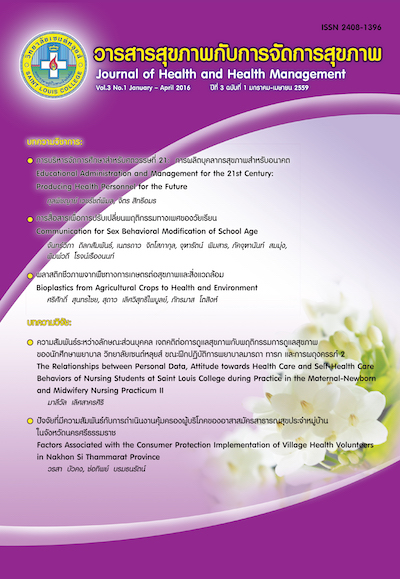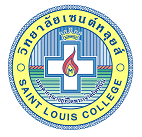Educational Administration and Management for the 21st Century: Producing Health Personnel for the Future
Keywords:
changing contexts, educational administration and management, health personnel, knowledgeAbstract
Flexner’s report about a century ago has been instrumental in the development of effective health science curricula. The health science educational institutions have produced personnel to serve health system leading to great improvement in individual and population health as well as increase in life expectancy. However, during the past century, there have been big changes in the contexts in which the health systems operate. Tremendous progresses have been noted in knowledge and technologies. Changes have also occurred in population structures, economy, society, and communications which impact health. Rapid transfer of information and migration of people within and between countries have been evident. These changes have led to higher cost of health care and also inequity between the rich and the poor with respect to access to services. Therefore, it is desirable that health personnel for the future must have desirable knowledge, skills, attitude and practice pattern to effectively cope with the changing situations. In additional to adequate professional knowledge, these personnel need competencies in asking the right questions, search for answers based on reliable evidences, and ability to apply good evidences within the context of health system in which the personnel operate. The graduates also need to have appropriate values and follow the sufficient economy principle in their practices. Finally, they must be ready to serve individuals and communities with keen respect for human dignity. As a consequence, health education institutions need reforms in several areas, including development of teachers, curricula and learning styles, students learning experiences, supporting systems and new feedback channels for the public and the alumni to improve the education programs. Meaningful evaluation must be built into the education reforms of the institutions.
References
Anand, S., & Barnighausen, T. (2004). Human resources and health outcomes: crosscountry econometric study. Lancet, 5(364), pp.1603–09.
Back, A.L., Steinhauser, K.E., Kamal, A.H., & Jackson, V.A. (2016, Feb 24). Building resilience for palliative care clinicians: An approach to burnout prevention based on individual skills and workplace factors. J Pain Symptom Manage, pii: S0885-3924(16)00073-7.
Bekelis, K., Missios, S., & Mackenzie, T.A. (2015, July). The association of insurance status and race with transfers of patients with traumatic brain injury initially evaluated at level III and IV Trauma centers. Ann Surg, 262(1), pp. 9-15.
Cohen, J.J., Cruess S., & Davidson C. (2007). Alliance between society and medicine: the public’s stake in medical professionalism. JAM, 298, pp. 670-73.
Cömert, M., Zill, J.M., Christalle, E., Dirmaier, J., Härter, M., & Scholl, I. (2016, March, 31). Assessing communication skills of medical students in objective structured clinical examinations (OSCE) - A systematic review of rating scales. PLoS One, 11(3), e0152717.
Conseil, A., Mounier-Jack, S., Rudge, J.W., & Coker, R. (2013). Assessing the effects of HIV/AIDS and TB disease control programmes on health systems in lowand middle-income countries of Southeast Asia: a semi-systematic review of the literature. Public Health. 127(12), pp. 1063-73.
Crispin, S.W. (2006, October 5). In Thailand, a return to ‘sufficiency’. Asia Time.
Curran, D., Xu, X., Dewald, S., Johnson, T.R., & Reynolds, R.K. (2012, September). An alumni survey as a needs assessment for curriculum improvement in obstetrics and gynecology. J Grad Med Educ, 4(3), pp. 317-21.
Firn. J, Preston. N, & Walshe. C. (2016, March). What are the views of hospital-based generalist palliative care professionals on what facilitates or hinders collaboration with in-patient specialist palliative care teams? A systematically constructed narrative synthesis. Palliat Med, 30(3), pp. 240-56.
Fishbain, D.A., Bruns, D., Disorbio, J.M., & Lewis, J.E. (2008, November). What are the variables that are associated with the patient’s wish to sue his physician in patients with acute and chronic pain?. Pain Med, 9(8), pp. 1130-42.
Flexner, A. (1910). Medical education in the United States and Canada: a report to the Carnegie Foundation for the Advancement of Teaching. New York: The Carnegie Foundation for the Advancement of Teaching.
Flexner, A. (1912). Medical education in Europe: a report to the Carnegie Foundation for the Advancement of Teaching. New York: The Carnegie Foundation for the Advancement of Teaching.
Frenk, J., Chen, L., Bhutta, Z.A, Cohen, J., Crisp, N., Evans, T., Fineberg, H., Garcia, P., Ke, Y., Kelley, P., Kistnasamy, B., Meleis, A., Naylor, D., Pablos-Mendez, A., Reddy, S., Scrimshaw, S., Sepulveda, J., Serwadda, D., Zurayk, H. (2010). The Lancet Commission Education of Health Professionals for the 21th Century: Health professionals for a new century: transforming education to strengthen health systems in an interdependent world. Lancet, 4(376), pp.1923–58.
Guyatt, G.l., Rennie, D., Meade, M.O., & Cook, D.J. (1993). User’s Guide to the Medical Literature: Essentials of Evidence-Based Clinical Practice. (Second Edition). New York: McGraw Hill & JAMA Archives Journals, American Medical Association. DOI: 10.1036/0071590382
Herrera, G.A., Zeng, C., Turbat-Herrera, E.A., & Teng, J. (2016). Healing the damaged mesangium in nodular glomerulosclerosis using mesenchymal stem cells (MSCs): Expectations and challenges. Ultrastruct Pathol, 40(2), pp. 61-70.
Ho, A., Spencer, M., & McGuire, M. (2015, August). When frail individuals or their families request nonindicated interventions: Usefulness of the four-box ethical approach. J Am Geriatr Soc, 63(8), pp. 1674-8.
Jacobs, J.C., van Luijk, S.J., Galindo-Garre, F., Muijtjens, A.M., van der Vleuten, C.P., Croiset, G., Scheele, F. (2014, October 16). Five teacher profiles in student-centred curricula based on their conceptions of learning and teaching. BMC Med Educ, 14(220), doi: 10.1186/1472-6920-14-220.
Kirkpatrick, D.L., & Kirkpatrick, J.D. (2007). Implementing the Four Levels. Newnan: Berrett-Koehler Publishers.
Mantovani, N., Pizzolati, M., & Gillard, S. (2015, October 5). Engaging communities to improve mental health in African and African Caribbean groups: a qualitative study evaluating the role of community well-being champions. Health Soc Care Community, DOI: 10.1111/hsc.12288.
Mate, K.S., Rooney, A.L., Supachutikul, A., & Gyani, G. (2014, Oct 17). Accreditation as a path to achieving universal quality health coverage. Global Health,10(68), DOI: 10.1186/s12992-014-0068-6.Mc
Menamin, R., Mc Grath, M., Cantillon, P., & Mac Farlane, A. (2014, April). Training socially responsive health care graduates: is service learning an effective educational approach?. Med Teach, 36(4), pp. 291- 307, doi: 10.3109/0142159X.2013. 873118.
Miyakis, S., Karamanof, G., Liontos, M., & Mountokalakis, T.D. (2006, December). Factors contributing to inappropriate ordering of tests in an academic medical department and the effect of an educational feedback strategy. Postgrad Med J, 82(974), pp. 823-9.
Monroe, K.S. (2016, Mar 11). The relationship between assessment methods and selfdirected learning readiness in medical education. Int J Med Educ. 7, pp. 75-80.
Monteith, S., Glenn, T., Bauer, R., Conell, J., & Bauer, M. (2016). Availability of prescription drugs for bipolar disorder at online pharmacies. J Affect Disord, 193, pp. 59-65.
Morgan, R., & Ensor, T. (2016). The regulation of private hospitals in Asia. Int J Health Plann Manage, 31(1), pp. 49-64.
Munro, K.M. (2008, November). Continuing professional development and the charity paradigm: interrelated individual, collective and organisational issues about continuing professional development.
Nurse Educ Today, 28(8), pp. 953-61, doi: 10.1016/ j.nedt.2008.05.015. Epub 2008 Jul 2.
Pasquel, F.J., Hendrick, A.M., Ryan, M., Cason, E., Ali, M.K., & Narayan, K.M. (2015). Cost-effectiveness of different diabetic retinopathy screening modalities. J Diabetes Sci Technol, 10(2), pp. 301-7.
Riley, K., & Schmidt, D. (2015, Dec 21). Does online learning click with rural nurses? A qualitative study. Aust J Rural Health, doi: 10.1111/ajr.12263.
Rosenzveig, A., Kuspinar, A., Daskalopoulou, S.S., & Mayo, N.E. (2014, November). Toward patient-centered care: a systematic review of how to ask questions that matter to patients. Medicine (Baltimore), 93(22), e120. doi: 10.1097/MD.0000000000000 120. Review.
Sawesi, S., Rashrash, M., Phalakornkule, K., Carpenter, J.S., & Jones, J.F. (2016). The impact of information technology on patient engagement and health behavior change: A systematic review of the literature. JMIR Med Inform. 4(1), e1.
Shringarpure, K.S., Isaakidis, P., Sagili, K.D., Baxi, R.K., Das, M., & Daftary, A. (2016, March 9). When treatment is more challenging than the disease: A qualitative study of MDR-TB patient retention. PLoS One, 11(3), e0150849.
Struckmann, V., Panteli, D., Legido-Quigley, H., Risso-Gill, I., McKee, M., & Busse, R. (2015). Deciding when physicians are unfit to practise: an analysis of responsibilities, policy and practice in 11 European Union member states. Clin Med (Lond), 15(4), pp. 319-24.
Stufflebeam, D. (2003). The CIPP model of evaluation, In T. Kellaghan, D. Stufflebeam, & L. Wingate (Eds), Springer international handbooks of education: International handbook of education. Netherlands: Springer.
Tagney, J., & Haines, C. (2009, April 23-May 13). Using evidence-based practice. Br J Nurs, 18(8), pp. 484-9.
Torres, J.M., & Waldinger, R. (2015). Civic Stratification and the Exclusion of Undocumented Immigrants from Cross-border Health Care. J Health Soc Behav. 56(4), pp. 438-59.
Waiswa, P., O’Connell, T., Bagenda, D., Mullachery, P., Mpanga, F., Henriksson, D.K., Katahoire, A.R., Ssegujja, E., Mbonye, A.K., Peterson, S.S. (2016, March 11). Community and District Empowerment for Scale-up (CODES): a complex district-level management intervention to improve child survival in Uganda: study protocol for a randomized controlled trial. Trials, 7(1), p. 135. doi: 10.1186/s13063-016- 1241-4.
Wangdi, K., Gatton, M.L., Kelly, G.C., & Clements, A.C. (2015). Cross-border malaria: a major obstacle for malaria elimination. Adv Parasitol. 89, pp. 79-107.
Whyte, S., Dixon, S., Faria, R., Walker, S., Palmer, S., Sculpher, M., Radford, S. (2016, March). Estimating the cost-effectiveness of implementation: Is sufficient evidence available?. Value Health,19(2), pp.138-44.
World Health Organization. (2013). Emergency response framework (ERF). WHO Press. World Health Organization. (2014a). Global status report on noncommunicable diseases. WHO Press.
World Health Organization. (2014b). A brief guide to emerging infectious diseases and zoonoses. WHO Press.
World Health Organization. (2015). Ageing and health. World Health Organization Report. WHO Press.



